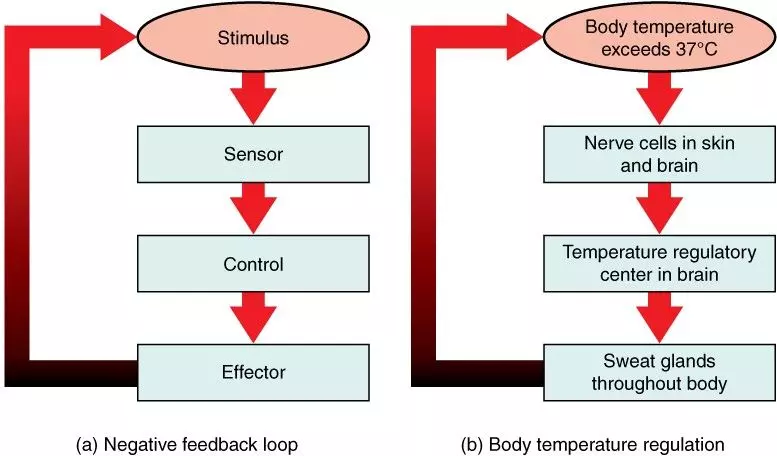Next Lesson - Metabolic and Endocrine Regulation
Abstract
- Temperature is regulated in the body through a negative feedback loop and needs to be maintained within a normal range, so that the body can function properly.
- The ideal temperature is around 37°C.
- The body has many mechanisms to help keep the temperature ideal such as shivering, sweating, vasoconstriction, vasodilation and voluntary actions.
- The elderly, the very young and those with chronic disease can struggle to put these mechanisms into place, meaning they can sometimes struggle to regulate their own body temperature.
Core
Temperature regulation (also called thermoregulation) is an important feature of human homeostasis. This is because, broadly, the body needs to balance; providing heat as activation energy for reactions in cells vs limiting heat so as not to denature any enzymes. This is done through a negative feedback loop, as shown in the diagram below. To learn more about feedback loops, see our article Introduction to Endocrinology in our Endocrinology series.

Diagram - Negative feedback shown diagrammatically, with regulation of body temperature used as an example
Creative commons source by OpenStax [CC BY-SA 4.0 (https://creativecommons.org/licenses/by-sa/4.0)]
The ideal body temperature is 37°C ± 1°C. This is the range at which the body can work most efficiently, and the temperature will oscillate within this range as the negative feedback loop circulates.
The sensors of temperature exist in the skin (measures external ambient temperature), and the hypothalamic preoptic area (detects core body temperature). The hypothalamic preoptic area measures the temperature of the blood directly and receives impulses from the thermoreceptors in skin and mucous membranes.
If the body is too hot, the following things occur to attempt to cool it:
- Increased release of acetylcholine leading to increased vasodilation.
- Sweating – sweat glands activated all over the body.
If the body is too cold, the following things occur to attempt to warm it:
- Increased release of adrenaline leading to increased vasoconstriction.
- Shivering – Repeated muscle contraction requires more ATP, so more respiration, which releases heat as a by-product.
Humans can also employ voluntary mechanisms, like putting on a jumper or seeking shade.
Classifications of Body Temperature
- <28°C – Life threatening Hypothermia
- <35°C – Hypothermia
- 36.5-37.5°C – Normal body temperature range
- >38°C – Hyperthermia
- >41°C – Severe Hyperpyrexia
It is important to know the definitions of hypo- and hyperthermia, because this will affect the management of a patient who presents at this temperature.
Difficulty Managing Body Temperature
There are many different groups of people that can struggle to regulate body temperature.
Changes occur in the body with age that make it more difficult to return to a normal temperature after experiencing thermodynamic extremes.
- Sweat glands become less active – meaning that the ability to perspire is reduced, making it harder for the elderly to cool themselves.
- Decreased subcutaneous fat deposition – decreased ability to retain heat.
- Slowed neurotransmitter synthesis pathway – this means that the control of vasodilation or vasoconstriction is reduced, so it cannot be used as effectively to cool the body or retain heat.
- Loss of muscle mass – shivering is less effective.
The very young struggle to control their temperature due to a couple of mechanisms that have failed to mature yet:
- Babies have few regulatory mechanisms as they rely on their brown fat to regulate their heat. However, this takes up a lot of energy so is not a long term option for heat production.
- Babies have immature neurological pathways, meaning they have not developed the ability to shiver yet. This means they struggle to warm themselves up.
- Babies also have a very large surface area to volume ratio, meaning that they have a large area of skin available for heat loos, but fewer cells able to produce heat.
- Babies also have the inability to carry out voluntary actions such as putting on a sweater and are unable to verbally communicate that they are cold.
Disease processes can also contribute to difficulties with thermoregulation.
- Those with poorly controlled and long-standing diabetes often have poor peripheral circulation due to the microvascular complications associated with diabetes. This means that it can often be difficult for their vessels to vasoconstrict or vasodilate on command, meaning that temperature regulation can be difficult.
- Very hot or very cold temperatures can cause flare ups of Multiple Sclerosis (MS). This can increase rigidity and worsen symptoms of MS. Patients with MS also can suffer from impaired ability to thermoregulate due to demyelination in the hypothalamic areas that control temperature regulation.
Edited by: Dr. Ben Appleby
Reviewed by: Dr. Thomas Burnell
- 18734

